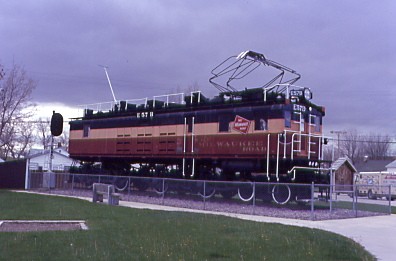
I slept until 7:15 AM before driving east from Superior to Deer Lodge, Montana.
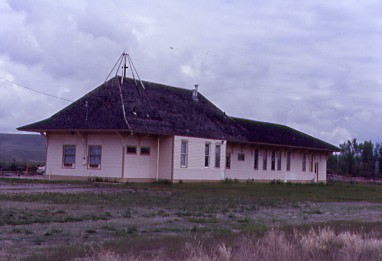
I asked a pastor of a church about what I was looking for and he told me I would find it at the Old Montana Prison. Chicago, Milwaukee, St. Paul and Pacific Deer Lodge station built in 1908. Deer Lodge was the division headquarters for the Milwaukee Road, officially known as the Chicago, Milwaukee, St. Paul and Pacific Railroad, until their demise in 1980. Here, the Milwaukee Road was electrified until June 15, 1974, when the conversion to diesel-electric locomotives retired all the line's electric locomotives. At one time Deer Lodge was the site of large railroad yards, shops and a roundhouse. The roadbed and many of the bridges are still intact across Montana, with BNSF trains passing by daily during the week.
The 2,300 mile Pacific Extension, which extended the railroad lines in the Midwest to the Pacific Ocean was built in 1906-1909. One of the premiere passenger trains ever to run on this continent, the Olympian Hiawatha, stopped here until it was discontinued in May 1961, ostensibly for lack of passenger traffic. It turned out that ridership was still showing respectable numbers, but the train was unprofitable nonetheless. Replacement trains continued to make Deer Lodge a stop until 1964, when the western terminus of passenger service was pulled back to Aberdeen, South Dakota. Today, it is home to the Community Evangelical Free Church.
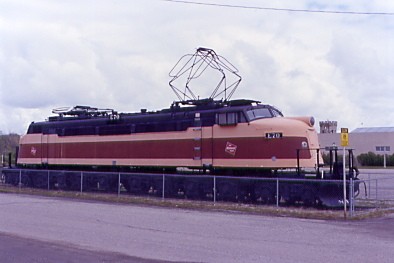
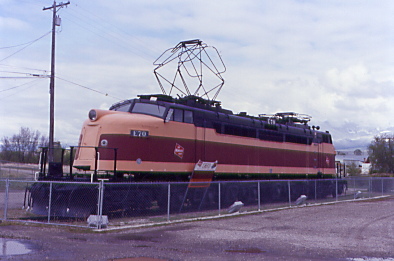

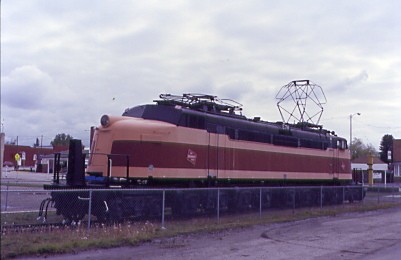

Along with the Northern Pacific Railroad's Last Spike May 19, 1909 is Milwaukee Road "Little Joe" EF-4 E70 built by General Electric in 1948. After World War II, the Soviet Railways continued its electrification program, this time targeting the Kropachyovo-Zlatoust-Chelyabinsk line of the South Urals Railway. As local factories were recovering from the war efforts, the Soviet government (then led by Joseph Stalin), ordered 20 of these locomotives. Known by their factory classification of GE 2-D+D-2 406/546 8-GE 750-3300V, in the Soviet Union, they would have received the classification of the A-series locomotive, with the A standing for Amerikanskiy elektrovoz, meaning "American electric locomotive". At the time this was the world's strongest electric locomotive, with a power output of 5,790 hp being comparable to the Union Pacific Big Boy.
The locomotives were built by General Electric at Erie, Pennsylvania, with the supervision of Soviet specialists. The Ministry of Railways of the USSR was so confident about receiving these locomotives, that they were also allocated running numbers, initially 1591-1610 and later 2301-2320. The first test run of the locomotive (unit A1598) took place on 7 September 1948 on a test track of the New York Central Railroad. GE built 20 locomotives of this type, but the company was prohibited from delivering them as relations between the United States and Soviet Union deteriorated into the Cold War. Fourteen were built to the Soviet gauge of 5 feet and the final six were built to standard gauge.
The locomotives were never delivered because the State Department banned sales of strategic goods to the Soviet Union whilst production was underway. This included the electric locomotives, which were considered strategic to the Soviet Railways. Before the ban, the tensions between the US and USSR caused the Soviet railway engineers to be recalled back to their country. GE completed the locomotives, but they were left with no owner. Two were damaged during the trials.
The Milwaukee Road had offered to buy all 20 locomotives, plus their spare parts, for $1 million. That was little more than scrap value, but GE accepted. However, the Milwaukee's Board of Directors would not release the money. Nonetheless, unit 29927 was tested on 24 December 1948 on the Milwaukee Road, but it revealed some issues during trials. Demand during the Korean War boosted the Milwaukee's need for locomotives on their electrified mainline. The railroad was also beset by a coal strike that required sending most diesels back East (Milwaukee Lines East steam engines still burned coal, unlike the oil-burning Lines West steamers). So the Board of Directors returned to GE, only to discover that eight locomotives and all the spare parts had been sold. Three had gone to the Chicago South Shore & South Bend Railroad and five to the Companhia Paulista de Estradas de Ferro of Brazil.
Still, the Milwaukee Road bought the remaining 12 locomotives for $1 million and railroad designated them as "class EF-4", denoting them as the line's fourth model of electric freight engine. Two units were modified before delivery for passenger service; these were designated "class EP-4". The Milwaukee's operating employees referred to the EF-4/EP-4 units as Little Joseph Stalin's locomotives, which was eventually shortened to simply Little Joe.
Today I was in search of all the remaining Milwaukee Road electric locomotives in the State of Montana so I drove back on Interstate 90 to Garrison and US Highway 12 just south of Mullan Pass.
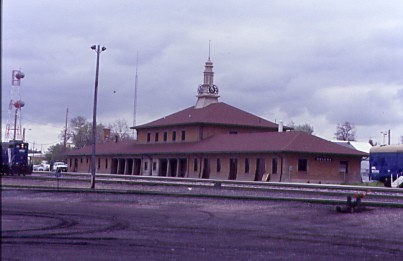
Northern Pacific Helena station built in 1904. The town went wild as the first long-awaited locomotive steamed into Helena on June 13, 1883. The momentous arrival of the Northern Pacific linked Montana to national markets and assured Helena a permanency not previously realized. The Sixth Ward grew almost overnight around the extensive rail yards. Hotels, saloons and businesses, some in tents, served the first passengers, crews and Sixth Ward residents, most of whom were railroad employees. Although the depot was a mile from downtown, horse-drawn cabs ferried visitors back and forth. By 1890, the district served four passenger trains daily. Today the small commercial district includes reminders of the territorial period and early twentieth century when the railroad ruled supreme.
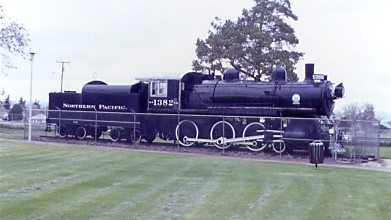
Northern Pacific 4-6-0 1382 built by Burnham-Williams in 1902. It was retired some time in the mid-1950's and donated to the City of Helena where it is on display near the Union Depot in Beattie Park.

Montana Rail Link GP9 115, ex. Chicago and North Western 4337, nee Chicago Great Western 120 built by Electro-Motive Division in 1951. I drove on east on US 12 to Harlowton in search of more Milwaukee Road.
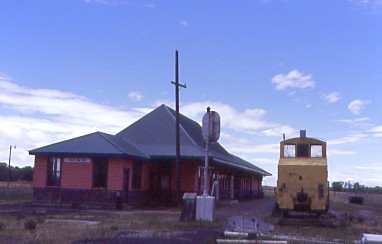
There I visited the nicely-restored station, shop switcher and wedge snowplough.
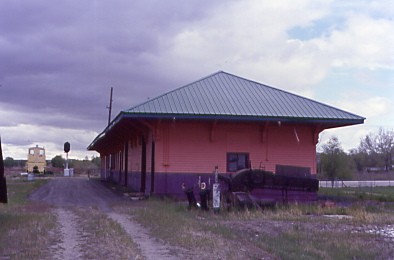
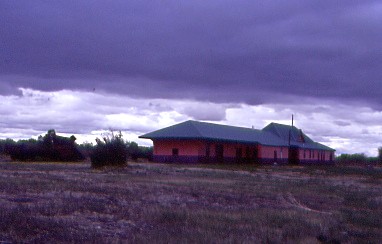
The Milwaukee Road Harlowtown station built in 1908 as a "Standard Class A Passenger Station", one of several standardized depot plans used by the Milwaukee Road. Passenger service was discontinued in 1961, and the depot and yards were abandoned in 1980. The depot was restored as a Milwaukee Railroad museum and is open to the public.
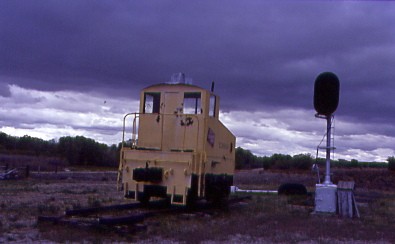
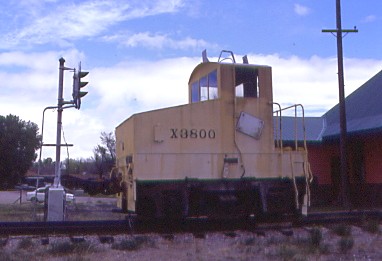
Milwaukee Road shop switcher X3800 built by the railroad and was used in Deer Lodge for switching duties. It is most unique in that it was powered using a 220 volt extension cord.
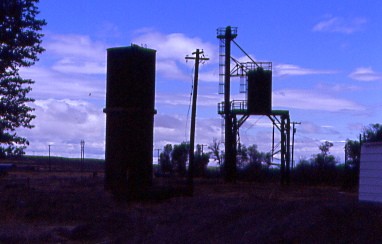
Rail service to Harlowton began in 1908 then in 1916, they gained international renown when the Milwaukee Road made the depot the eastern endpoint of an electrified section of rail which extended to Avery, Idaho. The electrified section was the longest stretch of electric railroad in the United States; Thomas Edison described the railroad as an "unmatched technical marvel". Harlowton was also an important division point for the railroad.
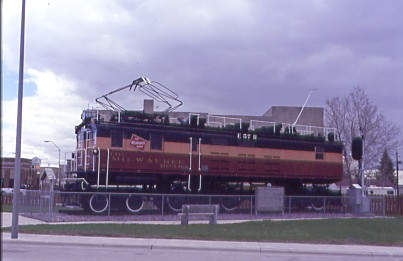
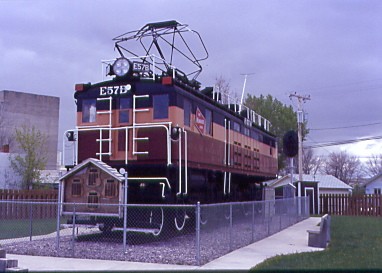
Milwaukee Road boxcab switcher 10211B built by General Electric in 1915 and painted as E57B. It was one of 42 of the EF-1 class (84 half locomotives semi-permanently connected together) which operated on the electrified section of the railroad, 656 miles in length, stretching from Harlowton to Avery, Idaho and from Othello, Washington to Tacoma, Washington in two non-adjoining sections. The Milwaukee turned to electrically-driven locomotives to pull trains over the mountain passes between Harlowton and Tacoma. It was seen that electric locomotives were capable of greater pulling power tham steam locomotives, while requiring less maintenance and incurring lower "fuel" costs.
In all, there were 116 electric locomotives built to service the electrified sections of the Milwaukee Road's western division which passed over five mountain ranges. Weighing 564,000 pounds, each unit produced up to 4,100 horsepower using 3,000 volts of direct current electricity. The advent of diesel locomotives proved to be the death knell for the electrics, though they managed to continue in operation for a couple of decades following the introduction of the diesels.
The electrification era on the Milwaukee Road ended at 11:40 PM on June 15, 1974 when Engineer Art Morang stopped the E57B and E34C on the Harlowton roundhouse track.
I drove north to Moore on US 191 and turned left on Montana 200 to Lewistown.
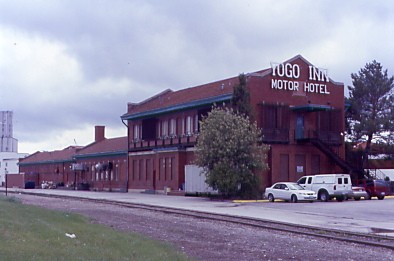
The Yogo Inn Hotel and Convention Center currently contains our commercial kitchen formerly known as "The Beanery", the waiting room became our Sapphire Ballrooms and the train conductor accommodations are our newly-renovated Premier King Guestrooms. In 1962, the newly-built Yogo Inn Motor Hotel with 60 rooms opened and with construction in 1983, it reached its current configuration of 123 rooms and the addition of the famous Centermark Courtyard which identifies the exact center of the state of Montana. During construction, several items were excavated from the Centermark location that dated back to the early 1900's. These artifacts can currently be viewed in the Yogo Inn lobby.

I walked over to the Great Northern station, built in 1912, which is currently an Exxon petrol station and casino. The Great Northern Railway, having already built a mainline between Billings and Great Falls in 1908, completed a 30 mile branchline from Moccasin to Lewistown in 1912. Construction of a line eastward from Lewistown, intended to reach New Rockford, North Dakota, was underway by 1913. The roadbed for this line was completed to Grass Range but the track was never laid. World War I brought a halt to construction and the project was never revived. Evidence of the roadbed can still be seen from the highway east of Lewistown.
I relaxed and had a true waterfall shower before maaking a hotel reservation for tomorrow night in Lincoln, Montana then called home before driving to the boarding location of our next rare mileage trip.
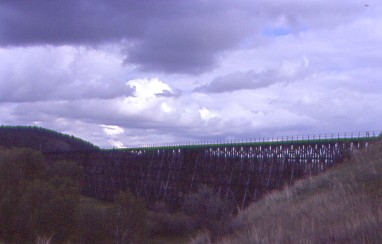
Spring Creek trestle at MP 70.8. The track between Lewistown and Kingston Junction is out of service due to the condition of this trestle, a long wooden trestle, which has deteriorated to the point that it is not safe for a train to cross. While it has been looked at, economics at the time does not support its repair.
Judith Basin Dinner Train on the Central Montana Rail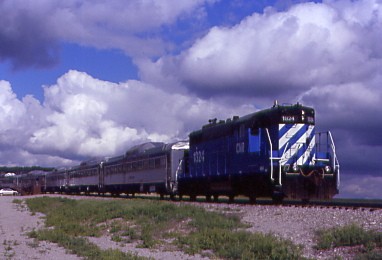
Montana Central Rail GP9 1824, ex. Burlington Northern 1824, nee Great Northern 1824 built by Electro-Motive Division in 1954.
Judith Basin Dinner Train Route HistoryThis area is certainly the high, great plains of Montana. While the various rail lines were being built through the area, towns were few and far between. This area was heavily promoted to homesteaders just before World War I, and thousands came to claim their 160 acres of land. This movement broke up the large cattle hldings but it did not last long. A combination of dry weather, hard living and higher wages available elsewhere during the War led most to leave the country by 1920. Much of the land eventually returned to the hands of the largest ranches or the few successful farmers, and today much of the country is a mix of giant wheat farms and grazing cattle.
The Great Northern bought the Montana Central which ran through Moccasin about 1910 and the railroad began to build a branch over to Lewistown to gain some of the business from the area's most important community. Business levels never reached the hopes of the Great Northern officials, but the line was very busy during the harvest season.
The line became Burlington Northern after the creation of the company with the merger of the Great Northern, Northern Pacific, Spokane, Portland and Seattle and Chicago, Burlington and Quincy railroads. In 1980, Burlington Northern acquired some of the former Milwaukee Road trackage in the area but traffic volumes still did not pay all of the bills. Eventually, the rail line between Moccasin and Kingston Junction was donated to the counties to operate.
The Great Northern line between Lewistown and Hanover was abandoned long ago. The trackage that Central Montana Rail acquired from Burlington Northern between Lewistown and Hanover is the former Milwaukee Road route. All mileposts are from a March 1938 Great Northern condensed track profile.
The ExcursionI reached the boarding area's dirt parking lot from where The Charlie Russell Chew Choo loads and it was just a wooden ramp. I photographed our train which was GP9 1824, RDC-9 6918, RDC-9 6926, RDC-1 6138, RDC-9 6906 and RDC-9 6916. The history of each RDC is as follows: 6918 is ex. North Shore Scenic Railroad 6918, exx. Massachusetts Bay Transportation Authority 6918, nee Boston and Maine 6918 built by Budd Company in 1956. 6926 is ex. North Shore Scenic Railroad 6926, exx. Massachusetts Bay Transportation Authority 6926, nee Boston and Maine 6926 built by Budd Company in 1956. 6138 is ex. North Shore Scenic Railroad 6138, exx. Massachusetts Bay Transportation Authority 6138, nee Boston and Maine 6138 built by Budd Company in 1955. 6906 is ex. North Shore Scenic Railroad 6906, exx. Massachusetts Bay Transportation Authority 6906, nee Boston and Maine 6906 built by Budd Company in 1956. Finally, 6916 is ex. North Shore Scenic Railroad 6916, exx. Massachusetts Bay Transportation Authority 6916, nee Boston and Maine 6916 built by Budd Company in 1956.
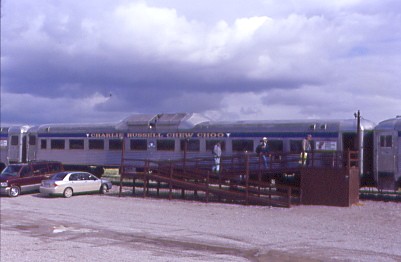
The passengers boarding our train.

The Central Montana Railroad operates a shortline between a connection with BNSF at Moccasin Junction to Geraldine, Montana. The railroad is made up of two separate sections of track. The north-south line to Geraldine is the former Milwaukee Road branchline which once ran between Harlowtown and Agawam. The line to Great Falls and beyond, and the many branches off it, where often referred to as the Northern Montana lines. The center section of the line, and the part that it became most known for, was the part between Lewistown and Great Falls. BNSF acquired the line after the collapse of the Milwaukee Road and the abandonment of their western lines.
The other part of the railroad, the east-west line, is the former Great Northern line between Lewistown and Moccasin Junction. Burlington Northern donated the lines to the State of Montana in 1983. In 1985, Central Montana Rail was created as a non-profit community development corporation to operate the line with service beginning on June 5, 1985. Central Montana operates the former Milwaukee Road line north of Lewistown as well as the former Burlington Northern/Great Northern line to the west. At the same time, BNSF operates the former Milwaukee Road line south of Lewistown. Thus, BN traded their former Great Northern route to Lewistown for the former Milwaukee Road route. To shorten this route, Burlington Northern built a new connection at Sipple about 20 miles north of the former Great Northern/Milwaukee Road connection and crossover of Judith Gap.
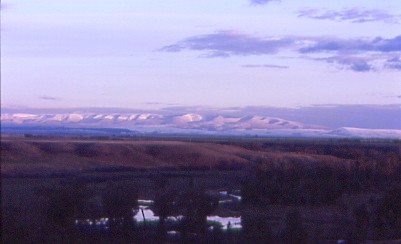
The train departed Kingston Junction, MP 21.3, at 6:13 PM and proceeded southwest towards Moccasin Junction, the Central Montana Rail connection to the BNSF.
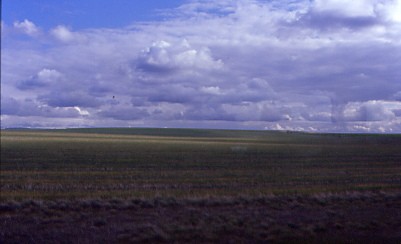
The grasslands of the Judith Basin, a rolling landscape surrounded by mountains ranges on all sides, over which our rare mileage dinner train would be crossing. The regular Charlie Russell Chew Choo dinner train route goes to Denton on the other part of the railroad we will be riding tomorrow.
This evening, I was dining with Martin from Arlington, Virginia. There were rolls on the tables and the waitress took drink orders then salads and more rolls were served as we continued through Rossfork and its siding and grain elevator at MP 14.1.
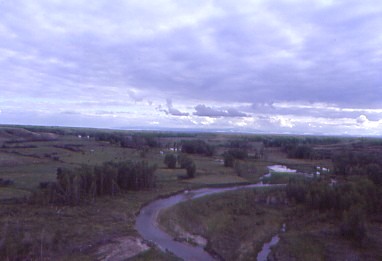
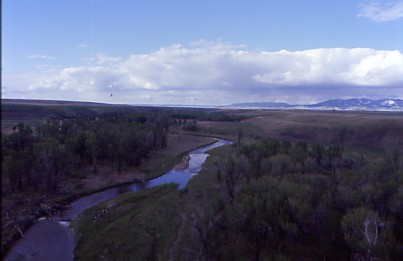
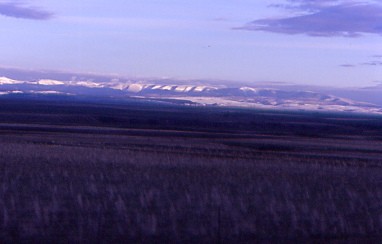
At MP 13.0, our train crossed the Judith River trestle which is the only long and high bridge on our journey. The river was named by Meriwether Lewis in 1805 for his cousin and later wife, Judith. We made a huge reverse curve to reach Kolin at MP 7.1 with its old buildings and grain elevator then had an excellent view of the Snowy Mountains to the east. Our prime rib dinners were served next and they were excellent.
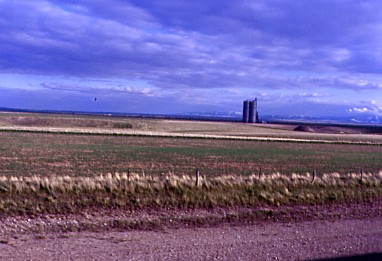
The recently-built grain elevator at Mocassin.
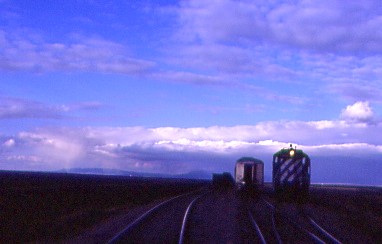
The train arrived at Moccasin Junction, MP 0.0, and everyone detrained to photograph the locomotive switching ends.
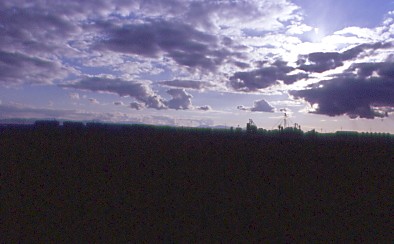
Mocassin with a BNSF freight, whose crew must have wondered what a passenger train was doing there. Once the engine was reconnected, we reversed almost all the way to the derail before we returned to Kingston Junction. Dessert was served which was a cheesecake with cherry sauce.
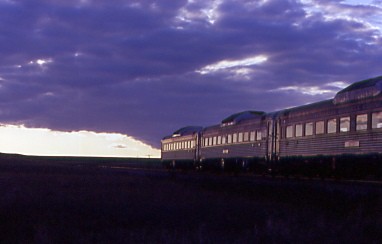
A photo runby was announced and this was the view as I detrained with the setting sun shining on the three RDCs.
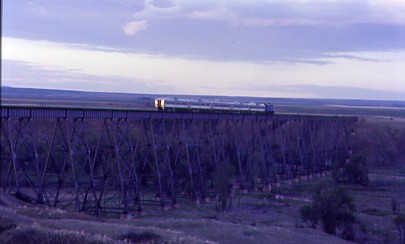
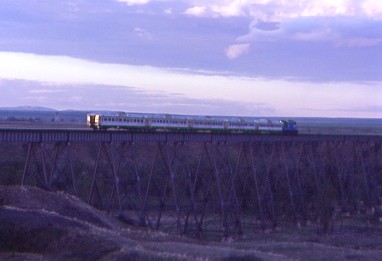
The photo runby at Judith River trestle.
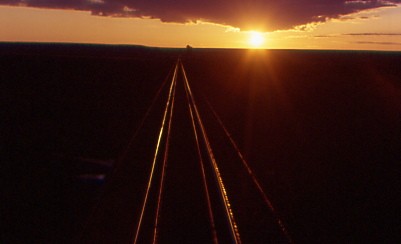
Sunset from the rear RDC. Once back aboard, we returned to Kingston Junction, ending the third rare mileage trip of this weekend. I drove back to Lewistown, stopping at an Albertson's for more slide film before returning to the Yogo Inn for the night.
| RETURN TO THE MAIN PAGE |